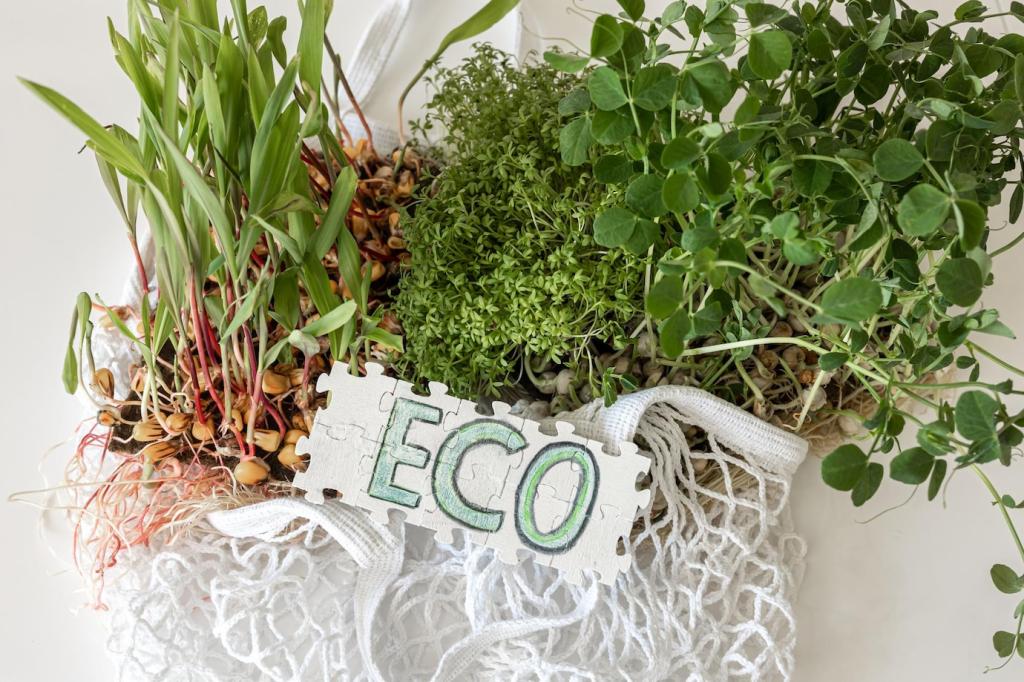Eco-Friendly Materials
Eco-friendly materials are at the forefront of sustainable design and innovation. As environmental concerns become ever more pressing, designers, architects, manufacturers, and individuals are turning to solutions that minimize harm to our planet. Eco-friendly materials are not only beneficial for the environment but also contribute to healthier living and a reduced carbon footprint. This page explores the importance, types, advantages, challenges, and real-world applications of eco-friendly materials across various industries, highlighting their essential role in building a sustainable future.

The Concept of Eco-Friendliness
The concept of eco-friendliness revolves around creating a cycle in which materials can be reused or naturally returned to the earth without causing harm. It emphasizes responsible resource use, minimal pollution during manufacturing, and options for recycling or biodegradation at the end of a product’s life. True eco-friendliness is not limited to what a material is made from; it also encompasses transportation, energy use, labor practices, and the product’s overall impact on the ecosystem. This broader perspective guides industries toward making more responsible decisions that benefit both the planet and future generations.
Lifecycle Assessment
Lifecycle assessment (LCA) is the scientific method used to evaluate the environmental impact of a material over its entire existence. By analyzing stages such as raw material extraction, production, transportation, usage, and end-of-life disposal, LCA can reveal hidden costs and benefits associated with different materials. This approach helps manufacturers and consumers choose truly eco-friendly materials, instead of those that may appear green superficially. Through LCA, eco-credentials can be quantitatively measured, leading to more informed decisions and strategies for responsible material use across industries.
Benefits for Environmental Health
One of the most compelling reasons to adopt eco-friendly materials lies in their capacity to reduce air, water, and soil pollution. Traditional materials—especially those derived from non-renewable or toxic sources—can burden ecosystems with persistent waste, leach harmful chemicals, or require excessive energy to produce. Eco-friendly alternatives impose less stress on environmental systems, supporting cleaner air and water, improved soil quality, and healthier habitats for both wildlife and humans. The integration of these materials is a proactive step toward reversing damage and creating a healthier world for future generations.
Sources of Eco-Friendly Materials
Plant-based materials have gained immense popularity due to their renewability and biodegradability. Products such as bamboo, hemp, cork, and organic cotton offer strong, versatile, and aesthetically pleasing alternatives to conventional materials like plastic or hardwoods. When sourced responsibly, these materials often require fewer pesticides, less water, and grow rapidly, making them ideal for sustainable manufacturing. As industries experiment with new plant-based composites, even traditional sectors like construction and textiles are reducing reliance on finite resources by embracing nature’s renewable bounty.

Applications in Construction and Architecture
Sustainable Building Materials
Materials like reclaimed wood, recycled steel, bamboo, and low-VOC paints exemplify sustainable building resources. They are chosen for their reduced environmental impact, whether through rapid renewability, recycled content, or energy-efficient properties. These materials contribute to certifications such as LEED or BREEAM, which recognize buildings for their environmentally conscious construction practices. By prioritizing these materials, architects and developers foster healthier living and working spaces while curbing the environmental damage associated with traditional building processes.
Green Insulation Solutions
Traditional insulation materials often contain chemicals and require energy-intensive manufacturing, which can harm both indoor air quality and the environment. Eco-friendly alternatives, such as cellulose made from recycled paper, sheep’s wool, and plant-based foams, deliver excellent thermal performance with a markedly reduced ecological footprint. These insulation options also promote healthier indoor environments and decrease the energy required to heat or cool a building. Their growing adoption reflects the industry’s commitment to innovation that benefits both people and the planet.
Low-Impact Interior Finishes
Eco-friendly interior finishes are designed to minimize exposure to harmful compounds and reduce environmental harm during installation and use. From paints free of volatile organic compounds (VOCs) to flooring made of cork, linoleum, or recycled glass, these materials contribute to healthier indoor air and lower the building’s overall ecological impact. Manufacturers are developing a wide array of finishes that not only meet aesthetic and functional needs but also adhere to increasingly strict environmental standards, promoting sustainability from the inside out.

Role in Fashion and Textiles
Organic fibers such as cotton, linen, and hemp are increasingly replacing conventional alternatives in fashionable garments. Grown without synthetic pesticides or fertilizers, these fibers have a much lower impact on soil and water systems. They are also less likely to trigger allergies or skin irritation, ensuring comfort and safety for wearers. With rising awareness and technological advancements, organic textiles are becoming available in a wider variety of textures and styles, making sustainability fashionable and accessible to all.
Advantages of Eco-Friendly Materials
Environmental Impact Reduction
The foremost advantage of eco-friendly materials is their ability to drastically reduce negative environmental impacts. By lowering greenhouse gas emissions, conserving resources, and promoting biodiversity, these materials address the root causes of environmental degradation. Their use in buildings, products, and infrastructure supports carbon neutrality and the preservation of natural habitats. As society faces the dual challenges of climate change and resource scarcity, eco-friendly materials become indispensable to a sustainable future.
Health and Safety Improvements
Materials that are free of toxic chemicals, allergic triggers, and persistent pollutants contribute directly to better human health. Indoor air quality improves with low-VOC paints and natural fibers, while biodegradable materials ensure that waste disposal does not jeopardize community health. These improvements are especially significant in settings like schools, hospitals, and homes, where vulnerable populations spend the majority of their time. The widespread adoption of safer, healthier materials is a major step toward overall societal well-being.
Economic Efficiency
Though eco-friendly materials can sometimes have higher upfront costs, they often generate economic savings over their lifecycle. Energy-efficient building products, durable recycled materials, and renewable resources can lower maintenance, operational, and waste management expenses. These economic benefits accrue to individual consumers, businesses, and entire communities, and are complemented by incentives and certifications that reward sustainable choices. As markets evolve, eco-friendly materials are becoming more cost-competitive, reinforcing their value across all sectors.

Supply Chain Complexity
The supply chains for eco-friendly materials can be complicated, with limited sources, variable quality standards, and logistical hurdles. Sourcing locally is not always possible, and transport can reduce some of the intended environmental benefits. Furthermore, certification processes and traceability often require significant time and expertise. Overcoming these supply chain challenges requires coordinated efforts among suppliers, manufacturers, and regulatory bodies to create transparent, efficient, and reliable systems that uphold sustainability standards.

Cost and Accessibility Issues
For businesses and consumers alike, the higher upfront cost of some eco-friendly materials can be a deterrent. While long-term savings are often possible, the initial investment may be prohibitive without financial incentives or subsidies. Accessibility is another concern, as these materials are not always widely available, particularly in developing regions. Bridging the gap between investment, affordability, and access is essential to democratize sustainable options and encourage widespread adoption.
Innovations and Future Trends
Smart and Adaptive Materials
Smart materials are engineered to adapt their properties in response to environmental changes, enhancing energy efficiency and resource management. Technologies such as self-healing concrete, thermochromic glass, and phase-changing insulation illustrate how scientific innovation is redefining sustainable design. These advancements allow buildings, vehicles, and products to minimize energy use and maintenance, paving the way for more resilient and sustainable infrastructure in an ever-changing world.
Carbon-Negative Materials
A breakthrough in eco-friendly innovation is the development of carbon-negative materials, which absorb more carbon dioxide than they emit during their lifecycle. Made from materials such as algae, biochar, or captured CO2, these products actively contribute to reversing climate change. Their integration into construction, packaging, and consumer goods demonstrates a proactive shift from merely reducing emissions to actively removing atmospheric carbon, setting a bold precedent for future sustainability standards.
Advances in Material Circularity
The pursuit of material circularity is encouraging the design and manufacture of products that can be continuously recycled or safely returned to nature. Companies are investing in closed-loop processes, modular designs, and biodegradable packaging that reinforce the principles of a circular economy. These innovations challenge the traditional linear take-make-dispose model and offer economic as well as environmental benefits. As circularity becomes integral to product development, waste will decrease, and resource efficiency will reach new heights.
How to Make Sustainable Choices
Evaluating Certifications and Labels
Certifications and eco-labels are valuable tools for identifying genuinely sustainable products, but understanding what each label means is crucial. Some labels indicate rigorous environmental and social standards, while others may be less stringent or even misleading. Consumers should familiarize themselves with reputable certifications, such as FSC for wood, GOTS for textiles, or Cradle to Cradle for general products. Scrutinizing these labels helps ensure that your purchasing choices support authentic sustainability rather than inadvertently contributing to greenwashing.
Supporting Local and Ethical Supply Chains
Choosing materials from local and ethically managed sources reduces transportation emissions and supports community resilience. Local sourcing not only shortens supply chains but also encourages investment in regional economies and labor standards. Furthermore, ethical supply chains prioritize fair wages, safe working conditions, and responsible resource management. By seeking out materials and products with traceable and ethical backgrounds, consumers can make a positive impact well beyond environmental factors alone.
Educating and Advocating for Change
Sustainable choices become more powerful when individuals and organizations educate themselves and others on the importance of eco-friendly materials. Sharing trusted information, supporting policy changes, and encouraging businesses to embrace sustainable practices amplifies collective impact. Advocacy at consumer, industry, and governmental levels is essential for shifting systems toward sustainable norms and increasing the availability and affordability of eco-friendly materials for all.
